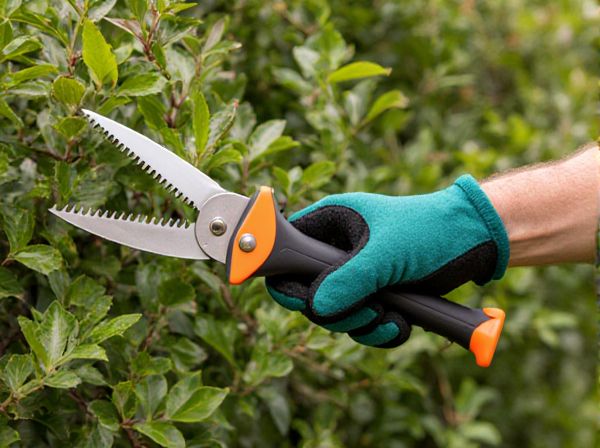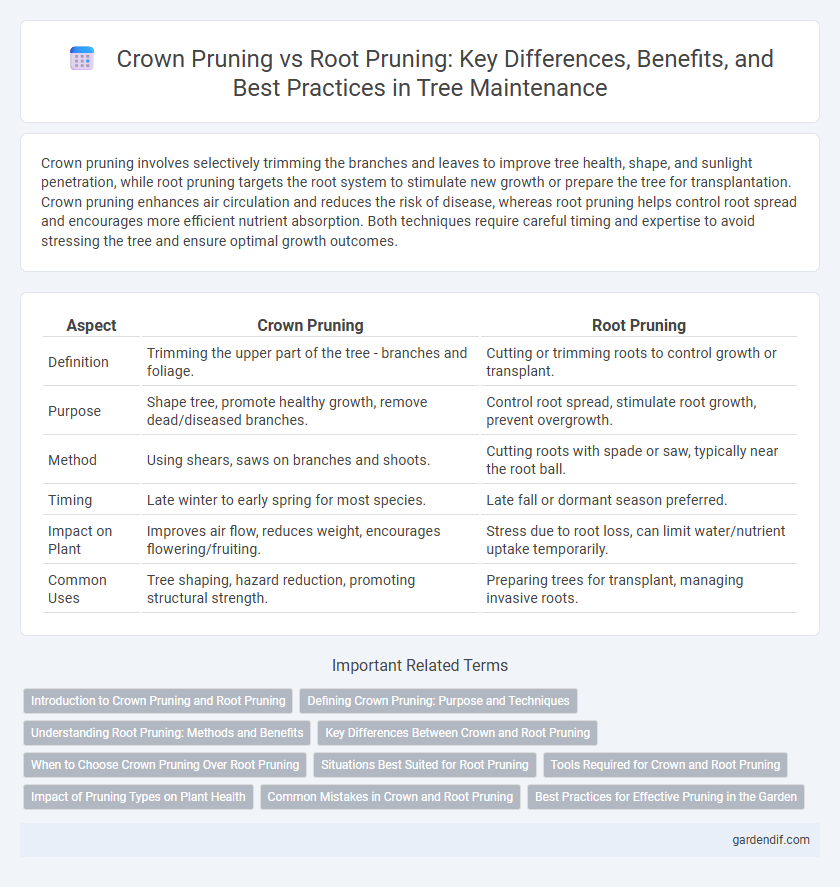
Crown pruning vs root pruning Illustration
Crown pruning involves selectively trimming the branches and leaves to improve tree health, shape, and sunlight penetration, while root pruning targets the root system to stimulate new growth or prepare the tree for transplantation. Crown pruning enhances air circulation and reduces the risk of disease, whereas root pruning helps control root spread and encourages more efficient nutrient absorption. Both techniques require careful timing and expertise to avoid stressing the tree and ensure optimal growth outcomes.
Table of Comparison
| Aspect | Crown Pruning | Root Pruning |
|---|---|---|
| Definition | Trimming the upper part of the tree - branches and foliage. | Cutting or trimming roots to control growth or transplant. |
| Purpose | Shape tree, promote healthy growth, remove dead/diseased branches. | Control root spread, stimulate root growth, prevent overgrowth. |
| Method | Using shears, saws on branches and shoots. | Cutting roots with spade or saw, typically near the root ball. |
| Timing | Late winter to early spring for most species. | Late fall or dormant season preferred. |
| Impact on Plant | Improves air flow, reduces weight, encourages flowering/fruiting. | Stress due to root loss, can limit water/nutrient uptake temporarily. |
| Common Uses | Tree shaping, hazard reduction, promoting structural strength. | Preparing trees for transplant, managing invasive roots. |
Introduction to Crown Pruning and Root Pruning
Crown pruning involves selectively trimming branches and foliage to improve a tree's structure, health, and aesthetic appeal by enhancing light penetration and air circulation. Root pruning targets the root system, typically by cutting roots around the perimeter of the root zone to stimulate growth, prevent root-bound conditions, and prepare the tree for transplantation. Both techniques play essential roles in maintaining tree vitality, managing growth, and ensuring long-term stability.
Defining Crown Pruning: Purpose and Techniques
Crown pruning involves selectively removing branches and foliage from the upper part of a tree to enhance its structure, health, and aesthetic appeal. Techniques include thinning to increase light penetration, crown reduction to decrease size, and cleaning to remove dead or diseased limbs, promoting better air circulation and growth. This practice supports balanced canopy development, reduces risk of branch failure, and improves overall tree vitality.
Understanding Root Pruning: Methods and Benefits
Root pruning involves carefully cutting back roots to stimulate healthier growth and improve nutrient absorption, often performed before transplanting trees or shrubs. Techniques include trenching around the root zone or using specialized tools to trim fibrous roots without damaging the main root ball. Benefits of root pruning include enhanced root structure, increased stability, and reduced transplant shock, promoting long-term plant health and vigor.
Key Differences Between Crown and Root Pruning
Crown pruning involves selectively removing branches and foliage to improve tree structure, light penetration, and air circulation, while root pruning targets cutting roots to encourage healthier root growth and prevent root girdling. The key difference lies in their focus areas; crown pruning enhances above-ground growth and aesthetic form, whereas root pruning directly influences the underground root system's health and stability. Both techniques serve distinct purposes in tree management but must be carefully balanced to maintain overall tree vitality.
When to Choose Crown Pruning Over Root Pruning
Choose crown pruning over root pruning when the goal is to improve tree structure, enhance light penetration, and promote healthy canopy growth without disturbing the root system. Crown pruning is ideal for managing tree size, shaping the crown, and removing dead or diseased branches in established trees. This method is preferred when maintaining overall tree health and stability is more important than stimulating root growth or controlling root spread.
Situations Best Suited for Root Pruning
Root pruning is best suited for situations involving transplanting large trees, controlling root spread in confined spaces, and improving tree health by stimulating new root growth. It is particularly effective in urban environments where roots threaten infrastructure or in container-grown plants needing root system management. Unlike crown pruning, root pruning targets the underground root area to enhance stability and nutrient uptake without significantly reducing the tree's canopy.
Tools Required for Crown and Root Pruning
Crown pruning requires tools such as hand pruners, loppers, pruning saws, and sometimes pole pruners for higher branches to efficiently remove dead or overgrown limbs. Root pruning involves specialized spading forks, root pruning saws, and sharp shovels to carefully cut and trim roots without damaging the plant's stability. Proper sterilization and sharp, durable blades are essential in both to prevent disease and ensure clean cuts for optimal plant health.
Impact of Pruning Types on Plant Health
Crown pruning improves air circulation and light penetration, promoting healthier foliage and reducing disease risk by removing dead or overcrowded branches. Root pruning stimulates new root growth and controls root spread, but excessive root loss can stress the plant and reduce nutrient uptake. Balancing crown and root pruning is essential to maintaining overall plant vigor and long-term health.
Common Mistakes in Crown and Root Pruning
Overlooking the balance between crown and root pruning often results in reduced tree vigor and increased vulnerability to pests and diseases. Common mistakes include excessive crown pruning that removes too much foliage, disrupting photosynthesis, and improper root pruning that damages critical root structures, impairing water and nutrient uptake. Ensuring precise cuts that respect the tree's physiological needs is essential for maintaining overall health and stability.
Best Practices for Effective Pruning in the Garden
Crown pruning focuses on selectively removing branches and foliage to improve tree structure, enhance light penetration, and promote healthy growth above ground. Root pruning involves trimming the roots to manage root spread, stimulate new root growth, and prepare plants for transplantation. Best practices include timing pruning during dormancy, using sterile, sharp tools, and balancing both crown and root pruning to maintain overall plant health and vigor in the garden.
Crown pruning vs root pruning Infographic

 gardendif.com
gardendif.com